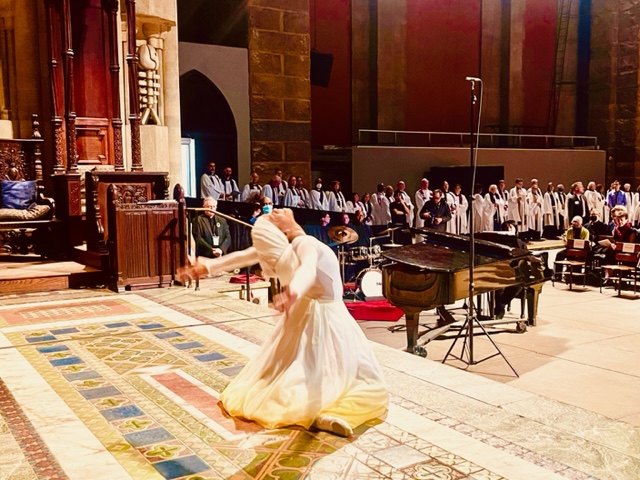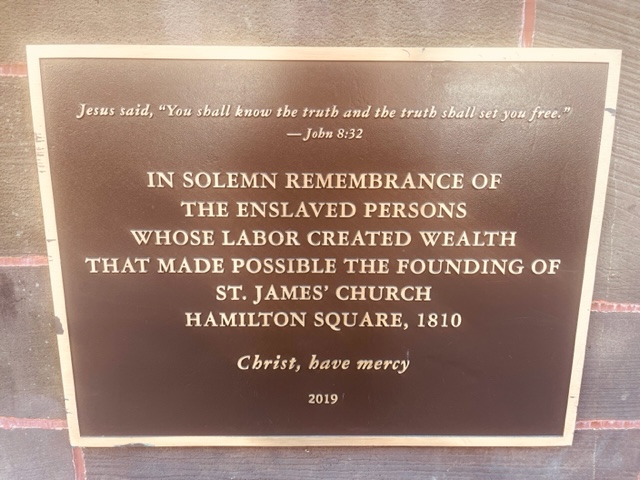
By Peggy Taylor
Last weekend, beneath the soaring granite pillars of the magnificent Cathedral Church of St. John the Divine, clergy, parishioners, and visitors assembled to witness an extraordinary ceremony: “We Are Complicit: The Episcopal Diocese of New York Apologizes for the Endurance of Slavery.”
The ceremony took place in Upper Manhattan, but its focus was on events which occurred in Lower Manhattan at Trinity Episcopal Church and St. Paul’s Chapel, between 1626 and 1827, when New York was America’s second largest slave port and when all of its structures, including its churches, were built by slaves. (Who can forget the 1991 discovery of the City’s African Burial Ground, where slaves and their descendants were interred outside the city limits behind today’s City Hall?)

The ceremony was deeply moving, rich in readings and prayers, and enhanced with music, dance, and song. Only a few hundred people attended, so some of us were invited to sit, not in the nave far from the sanctuary, but in the beautifully carved choir stalls near the altar.

In a solemn and eloquent sermon delivered midway through the service, the Right Reverend Andrew Dietsche, XVI Bishop of New York, described the event as “a long time coming,” and “a moment to undo and repair some of the harm that we have done to people of African descent.” “We could not have become the great diocese that we became without wealth gained by Episcopalians and their investment in slavery; that wealth helped build the magnificent edifices which are our churches and created the foundation for the endowments which have supported our churches throughout this long history and still do.”

The Reverend Trevor Babb, whom I interviewed in the choir stall, noted that the Apology was “not the end of, but the beginning of a process of healing.” Retired Reverend Charles Kramer, concurred: “We can’t progress without stopping, lamenting, grieving and apologizing for the sins that the church as a whole has committed.”
So what exactly were those sins, I asked Reverend Kramer, looking for more specificity. The Diocese was apologizing, he said, for having slaveholders among its members; for using slave labor to build its churches, not only in New York City, but up and down the Hudson River Valley; for investing in, insuring, and captaining slave ships; for having members who financed parishioners’ purchases of slaves; for using slaves to maintain their households and churches; for not supporting abolition; for having pastors like the one from its Ossining parish who, when Lincoln’s funeral train passed it, raised the Confederate Battle Flag; for segregating slave worshippers in cramped slave galleries, sweltering in summer, freezing in winter, while also barring them from actively participating in the life of the Church. (The galleries in St. Augustine’s Church on the Lower East Side are still intact); for erecting barriers to advancement for Black pastors who, no matter how qualified, rarely reach the highest rungs of the Church’s hierarchy.
Bishop Dietsch acknowledged that not all Episcopalians approve of the Apology. “Our ancestors weren’t slaveholders, some even fought for the Union,” they object. But the Bishop replies: “Sometimes we are a collection of persons and sometimes we are a people. This is an institutional apology being offered by the Diocese of New York as an entity.”

Many Black Episcopalians attended the ceremony. Among them, Ginger D. from Philadelphia, who made the trip in memory of her grandfather who once headed a parish there. There has been a lot of racism in the ministry,” she said, “but I had to represent him here.”
Also attending were descendants of New York parishioners who once sat in the slave galleries— members of St. Philip’s Episcopal Church, whose ancestors broke away from Trinity in 1809 and built their own church, first on Center, then, Mulberry, then West 27th Streets, before finally moving to Harlem. Mark Barksdale, a third generation St. Philip’s member and architect, said that an apology was due, “not only for slavery but also for segregation.”

Tod Roulette, a twenty-two-year St. Philip’s member and City College lecturer, said it was important for the Church to take the lead and influence secular institutions. “It’s one thing to have Harvard do it; it’s another thing to have religious institutions do it,” he said.
Another member, however, expressed bitterness about the Church. Remembering the 1863 Draft Riots when Black churches were destroyed by Irish immigrants protesting the draft, he noted that, “The only help we got was from the National Guard, not the Church.” “An apology is fine, but you also have to do something to atone for what you’ve done,” he added. The Apology is “a good first step. Now, let’s see what else the Church does.”

A plaque in front of St. James’ Episcopal Church on Madison Avenue acknowledges the Church’s role in perpetuating slavery. It reads: “In solemn remembrance of the enslaved persons whose labor created wealth that made possible the founding of St James’ Church in 1810.”
After the Apology and the plaque, what’s next?
The Diocese has pledged to institute a $1.1 million fund, through which a Reparations Commission will work “to repair the historic and contemporary damage done to people of African descent.” Bishop Dietsche said that talks about reparations “so far have centered on providing college scholarships as well as health care and housing, along with clearing institutional obstacles that have prevented African Americans in the church from working at ‘high-profile parishes and dioceses.’”
The Episcopal Church is setting an estimable example. Will $1.1 million be enough?









How about all immigrants that came here in the last 300-400 years? Italians. Irish. Chinese. Jews. Muslims.
Many were treated in the most terrible way possible. And slavery has not existed in NY state since July 4, 1827.
How far back do we go?
The groups that you site were not systematically stripped from their families & homelands by organized slave trading profiteers who trafficked Africans for the sole purpose of developing anew nation.
Quite a big difference.
The most terrible treatment possible is to be denied the ownership of your own body. It is true that many immigrants suffered discrimination, exploitation and other mistreatment, such as my grandfather. The KKK burned crosses in front of his home because he was an immigrant. But still he came to this country voluntarily rather than in chains, earned his own living, however meager, and raised his own children without fear that they might be sold away. Only enslaved peoples were denied those basic human rights.
Asians and Jews have seen a huge upswing in violence towards them since the pandemic. It’s disgusting and largely ignored.
You’re right but since Trump, not since the pandemic.
You belittle the victims of these assaults based on race and religion, by your political obsession. These people, particularly the Asian women who were murdered, deserve respect, so stop it.
Most people are not responsible for what happened in the past, however horrific it was. Why should they be punished financially for someone else’s sins? Not to mention it was 2 centuries ago!
No people are being held responsible here. No one is being punished. The Diocese, an institution, is paying reparations, and paying them voluntarily. Merriam-Webster defines reparations as “the act of making amends, offering expiation, or giving satisfaction for a wrong or injury.” The Diocese, which has existed continuously for those 200 years, has decided that it wrongly benefited — and has noticed that it still reaps benefits from those wrongs even today — and wishes to make amends to the descendants of those it harmed.
Good to know that money apparently grew on trees and didn’t come from anyone’s pocket.
I truly don’t understand these lazy reactionary comments – no one is being punished financially here.
I have never read a comment from UWS Dad that wasn’t condescending or belittling someone.
Diocese is making the choice to apologies for past actions of the church, no one is being punished… plenty of confused comments here, please get the facts right
Because our systems continue to promote bias & work against progress for people of color.
Surely our country had a very ugly past. But what present day systems are you referring to now?
We had a president who is a person of color. Our VP is a person or color. WH press Secretary is a lesbian person of color. Lots of NYS politicians are people of color. Our Mayor and DA are people of color. And we are still talking about bias and discrimination?
Very good point. I’m echoing the same question @Jane Otto – what current systems keep promoting bias and work against progress for people of color? Specifics are appreciated.
What systems continue to promote bias? What exactly they are doing against progress for people of color?
Give me a break. I’m a person of color.
The current climate is nothing but a political game of victimhood. Obama is a person or color. He also didn’t instill the popular with the current administration culture of victimhood and handouts. His slogan was “yes, we can”. And it was very motivating. What’s going on now is ridiculous and helps no one.
It only creates division and fans racial tension.
It surely does. It wasn’t that bad only a few years ago.
Great article! It seems that $1.0 million is a paltry response to the opportunity to do good. Harvard allocated $100 million!
The Episcopal Church ain’t what it used to be . Few parishioners, not so much property, a lot of crumbling buildings, little social influence. We can hope this gesture is a beginning, and finds some worthy destinations- some harms were mentioned.
This interesting article raises several important issues. However, I would appreciate a WSR fact check on this point: “New York was America’s second largest slave port … all of its structures, including its churches, were built by slaves.” This same assertion was made about the college I attended, when in fact itsbuildings were build by Italian stonemasons whose descendants still live in the town.
As I understand it, all of Lower Manhattan’s structures before slavery was abolished in New York State in 1827 were built by slaves. At that time New York was the second largest slave port after Charleston. I’d be interested to know which college you attended and when the buildings were constructed.
I believe it is dangerous and divisive to tell one group of people that another group “owes them something “. Other than my mortgage, I don’t owe nobody a damn thing. I also think this constantly telling people that one group is responsible for the problems of others is partly responsible for some of the “random ” attacks on Upper West Siders. Why don’t we focus on unity instead of divison .
Given the logic of the article and some commentators , men owe women big time. We couldn’t vote, couldn’t have our own finances, the list goes on. And that was less than 100 years ago! So, men, pay up! 🙂
P.S. I don’t accept cryptocurrency.